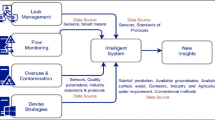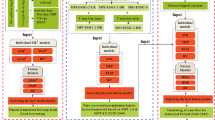Abstract
Dust storms in the Sanandaj area in the western region of Iran, mainly during spring and summer, have become an environmental crisis. Prediction of dust storm occurrences helps the residents to their detrimental effects. However, no study has been conducted to determine the accuracy of the Adaptive Neuro-Fuzzy Inference System (ANFIS) model in predicting dust storm occurrences. For that purpose, the prediction accuracy of ANFIS model was compared with that of two conventional models used for dust storm prediction: the Artificial Neural Networks (ANN), and Multiple Regression (MLR) models. Daily mean meteorological variables from Damascus (Syria) and PM10 concentration, measured at a ground station in Sanandaj, Iran, from 2009 to 2012, were selected as independent and dependent variables, respectively. After data normalization between zero and one, the data from 2009 to 2011 were used for the simulation, while the data of 2012 were utilized for testing the models. The performance of the ANFIS model in simulating dust storm occurrences was higher compared with those of MLR and ANN. In the simulation results, among the three models, the highest Pearson correlation coefficient between the observed and the estimated dust storm occurrences was obtained for the ANFIS model. The prediction tests showed that the accuracy of the ANFIS model was higher compared with ANN and MLR. From the results of this study, it can be concluded that the ANFIS model has the potential to forecast dust storm occurrences in western Iran by using meteorological variables of the dust storm creation zone in the Syrian deserts.











Similar content being viewed by others
References
Amanollahi J, Kaboodvandpour Sh, Abdullah AM, Ramli MF (2011) Accuracy assessment of moderate resolution image spectroradiometer products before and during dust storms. Int J Environ Sci Technol 8(2):373–380
Amanollahi J, Kaboodvandpour Sh, Abdullah AM, Rashidi P (2012) Assessment of vegetation variation on primarily creation zones of the dust storms around the euphrates using remote sensing images. Environ Asia 5(2):76–81
Barnum BH, Winstead NS, Wesely J, Hakola A, Colarco PR, Toon OB, Ginoux P, Brooks G, Hasselbarth L, Toth B (2004) Forecasting dust storms using the CARMA-dust model and MM5 weather data. Environ Model Softw 19(2004):129–140
Chang TC (2007) Risk degree of debris flow applying neural networks. Nat Hazards 42(1):209–224
Chang LC, Chang FJ (2001) Intelligent control of modeling of real time reservoir operation. Hydrol Process 15(9):1621–1634
Chaudhuri S, Middey A (2001) Adaptive neuro-fuaay inference system to forecast peak gust speed during thunderstorms. Meteorol Atmos Phys 114(3–4):139–149
Chen HW, Wang ML (1996) The review of dust storm researches in Northwest China (in Chinese). Gansu Meteorol 14:8–10
Falaschi F, Giacomeli F, Federici PR, Puccinelli A, D’Amato Avanzi G, Pochini A, Ribolini A (2009) Logistic regression versus artificial neural networks: landslide susceptibility evaluation in a sample area of the Serchio River valley, Italy. Nat Hazards 50(3):551–569
Guneri AF, Ertay T, Yucel A (2011) An approach based on ANFIS input selection and modeling for suplier selection problem. Exp Syst Appl 38(12):14907–14917
Hadjimitsis DG, Clayton CRI (2008) The use of an improved atmospheric correction algorithm for removing atmospheric effects from remotely sensed images using an atmosphere-surface simulation and meteorological data. Meteorol Appl 15(3):381–387
Hadjimitsis DG, Clayton CRI, Hope VS (2004) An assessment of the effectiveness of atmospheric correction algorithms through the remote sensing of some reservoirs. Int J Remote Sens 25(18):3651–3674
Haywood J, Boucher O (2000) Estimates of the direct and indirect radiative forcing due to tropospheric aerosols: a review. Rev Geophys 38(4):513–543
Hewitson BC, Crane RG (1994) Neural nets: applications in geography. Kluwer, Netherlands
Huang M, Li KR, Li XB (2006a) Climatic forecast models of land cover (in Chinese). Acta Geogr Sin 55:64–70
Huang M, Peng G, Zhang J, Zhang S (2006b) Application of artificial neural networks to the prediction of dust storms in Northwest China. Glob Planet 52(1–4):216–224
Iran Metrological Organization (IMO) (2010) http://www.irimet.net
Jang J-SR (1993a) ANFIS: adaptive-network-based fuzzy inference system. IEEE Trans Syst Man Cybern 23(3):665–685
Jang J-SR (1993b) Fuzzy modeling using generalized neural networks and Kalman filter algorithm. Proceedings National Conference on Artificial Intelligence (AAAI-91), pp 762–767
Jang J-SR, Gulley N (1995) The fuzzy logic toolbox for use with MATLAB. The Math Works, Natick
Jang J-SR, Sun CT, Mizutani E (1997) Neuro-fuzzy and soft computing: a computational approach to learning and machine intelligence. Prentice-Hall, New Jersey
Kamatchi P, Balaji Rao K, Lyer NR, Arunachalam S (2012) Neural network-based methodology for inter-arrival times of earthquakes. Nat Hazards 64(2):1291–1303
Kaufman YJ, Tanre D, Boucher O (2002) A satellite view of aerosols in climate systems. Nature 419:215–223
Krewski D, Bumett RT, Goldberg MS, Hoover K, Siemiatycki J, Jerrett M, Abrahamowicz A, White WH (2000) Reanalysis of the Harvard six cities study and the american cancer society study of particulate air pollution and mortality: a special report of the institute’s particle epidemiology reanalysis project. Health Effects Institute, Cambridge MA, (97 pp). http://pubs.healtheffects.org/getfile.php
Lu P, Rosenbaum MS (2003) Artificial neural networks and grey system for the prediction of slope stability. Nat Hazards 30(3):383–398
Maas O, Boulanger J, Thiria S (2000) Use of neural networks for predictions using time series: illustration with the El Niño Southern oscillation phenomenon. Neurocomputing 30(1–4):53–58
Matlab (2012) Anfis and the ANFIS editor. http://www.mathworks.com/help/fuzzy/anfis-and-the-anfis-editor-gui.html
Mikami M, Abe O, Du M (2002) The impact of aeolian dust on climate: Sino-Japanese cooperative project ADEC. J Arid Land Stud 11:211–222
Moseholm L, Silva J, Larson T (1996) Forecasting carbon monoxide concentrations near a sheltered intersection using video traffic surveillance and neural networks. Transp Res 1(1):15–28
Naderloo L, Alimardani R, Omid M, Sarmadian F, Javadikia P, Torabi MY, Alimardani F (2012) Application of ANFIS to predict crop yield based on different energy inputs. Measurement 45(6):1406–1413
NASA (2008) National aeronautics and space administration. http://gcmd.nasa.gov/records/GCMD_MOD021KM.html
Natsagdorj L, Jugder D, Chung YS (2003) Analysis of dust storms observed in Mongolia during 1937–1999. Atmos Environ 37(9):1401–1411
Noori R, Hoshyaripour G, Ashrafi K, Nadjar Arrabi B (2010) Uncertainty analysis of developed ANN and ANFIS model in prediction of carbon monoxide daily concentration. Atmos Environ 44(4):476–482
Nørgaard M, Ravn O, Poulsen NK, Hansen LK (2000) Neural networks for modelling and control of dynamic systems. Springer, London
Nourani V, Pradhan B, Ghaffari H, Sharifi SS (2014) Landslide susceptibility mapping at Zonouz plain, Iran using genetic programming and comparison with frequency ratio, logistic regression, and artificial neural network models. Nat Hazards 71(1):523–547
Nunnari G, Dorling S, Schlink U, Cawley G, Foxall R, Chatterton T (2004) Modelling SO2 concentration at a point with statistical approaches. Environ Model Softw 19(10):887–905
Odabasi M, Bagiroz HO (2002) Sulfate dry deposition fluxes and overall deposition velocities measured with a surrogate surface. Sci Total Environ 297(1–3):193–201
Perez-Roaa R, Castroa J, Jorqueraa H, Perez-Correaa JR, Vesovic V (2006) Airpollution modeling in an urban area: correlating turbulent diffusion coefficients by means of an artificial neural network approach. Atmos Environ 40(1):109–125
Ponnambalam K, Karray F, Mousavi SJ (2003) Minimizing variance of reservoir systems operations benefits using soft computing tools. Fuzzy Sets Syst 139(2):451–461
Prospero JM, Ginoux P, Torres O, Nicholson SE, Gill TE (2002) Environmental characterization of global sources of atmospheric soil dust identified with the Nimbus 7 Total Ozone Mapping Spectrometer (TOMS) absorbing aerosol product. Rev Geophys 40(1):2–31
Seinfeld JH, Pandis SN (1998) Atmospheric chemistry and physics-from air pollution to climate change. Wiley, New York
Sfetsos A (2000) A comparison of various forecasting techniques applied to mean hourly wind speed time series. Renew Energy 21(1):23–35
Shao Y, Leslie LM (1997) Wind erosion prediction over the Australian continent. J Geophys Res 102(D25):30091–30105
Shao Y, Jung EJ, Leslie LM (2002) Numerical prediction of northeast Asian dust storms using an integrated wind erosion modeling system. J Geophys Res 107(D24):4814–4836
Sharma ML, Tyagi A (2010) cyclic behavior of seismogenic sources in India and use of ANN for its prediction. Nat Hazards 55(2):389–404
Shirmohammadi B, Moradi H, Moosavi V, Semiromi MT, Zeinali A (2013) Forecasting of meteorological drought using Wavelet-ANFIS hybrid model for different time steps (case study: southeastern part of east Azerbaijan province, Iran). Nat Hazards 69(1):389–402
Sun J, Zhang M, Liu T (2001) Spatial and temporal characteristics of dust storms in China and its surrounding region, 1901–1999: relations to source area and climate. J Geophys Res 106:325–333
Tanaka K, Sano M, Watanabe H (1995) Modeling and control of carbon-monoxide concentration using a neuro-fuzzy technique. IEEE Trans Fuzzy Syst 3(3):271–279
Tegen I, Fung I (1994) Modeling of mineral dust in the atmosphere: source, transport and optical thickness. J Geophys Res 99(D11):22897–22914
Tzanis C, Varotsos C, Ferm M, Christodoulakis J, Assimakopoulos MN, Efthymiou C (2009) Nitric acid and particulate matter measurements at Athens, Greece, in connection with corrosion studies. Atmos Chem Phys 9:8309–8316
Tzanis C, Varotsos C, Christodoulakis J, Tidblad J, Ferm M, Ionescu A, Lefevre RA, Theodorakopoulou K, Kreislova K (2011) On the corrosion and soiling effects on materials by air pollution in Athens, Greece. Atmos Chem Phys 11:12039–12048
Varotsos C, Tzanis C, Cracknell A (2009) The enhanced deterioration of the cultural heritage monuments due to air pollution. Environ Sci Pollut Res 16(5):590–592
Wei M, Bai B, Sung A, Liu Q, Wang J, Cather M (2007) Prediction injection profiles using ANFIS. Inf Sci 177(20):4445–4461
Who (2005) Air quality guidelines global update 2005. Report on a working group meeting, Bonn, Germany, 18–20 October, p. 25. http://www.euro.who.int/document/e87950
Williams R, Suggs J, Rea A, Leovic K, Vette A, Croghan C, Sheldon L, Rodes Ch, Thomburg J, Ejire A, Herbst M, Sanders W (2003) The research triangle park particulate matter panel study: PM mass concentration relationships. Atmos Environ 37(38):5349–5363
Yang YQ, Wang JZ (2005) An integrated decision method for prediction of tropical cyclone movement by using genetic algorithm. Sci China Ser 48(3):52–68
Yun HJ, Yi SM, Kim YP (2002) Dry deposition fluxes of ambient particulate heavy metals in a small city, Korea. Atmos Environ 36(35):5449–5458
Zadeh LA (1965) Fuzzy sets. Inform Control 8:338–353
Zhou ZJ (2001) Blowing sand and sand storm in china in recent 45 years. Quat Sci 21:9–17
Acknowledgments
The researchers are grateful to Associate Prof. Dr. Ahmad Makmom Abdullah from Universiti Putra Malaysia for his comments on dust storm creation process. Also, we appreciate Mrs. Kazhal Habibzadeh from Environment Protection Organization of Kurdistan province for her provision of the PM10 data.
Author information
Authors and Affiliations
Corresponding author
Rights and permissions
About this article
Cite this article
Kaboodvandpour, S., Amanollahi, J., Qhavami, S. et al. Assessing the accuracy of multiple regressions, ANFIS, and ANN models in predicting dust storm occurrences in Sanandaj, Iran. Nat Hazards 78, 879–893 (2015). https://doi.org/10.1007/s11069-015-1748-0
Received:
Accepted:
Published:
Issue Date:
DOI: https://doi.org/10.1007/s11069-015-1748-0




